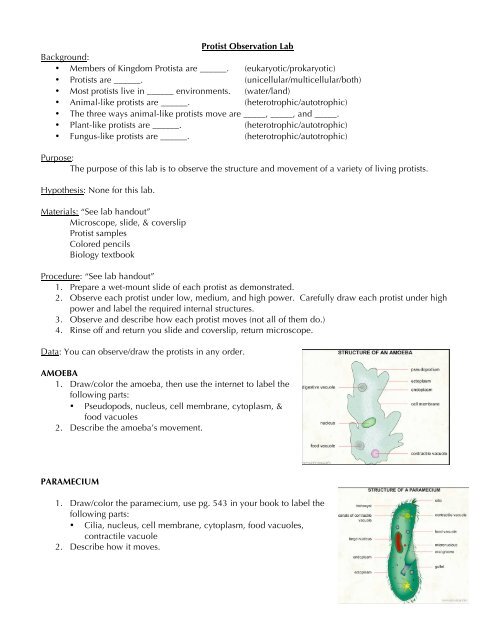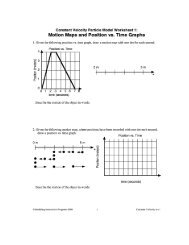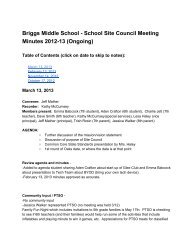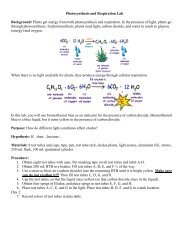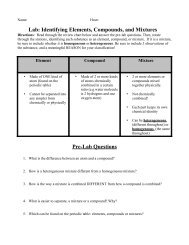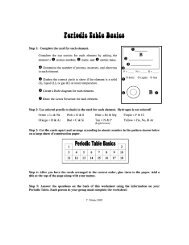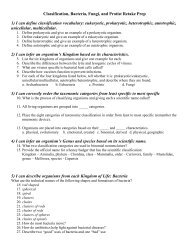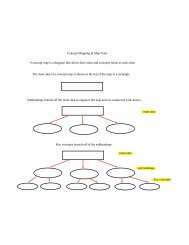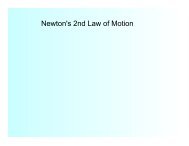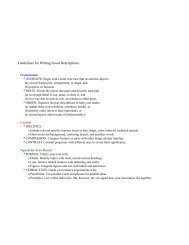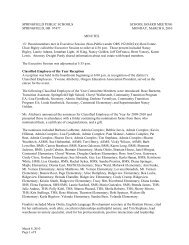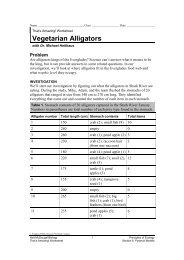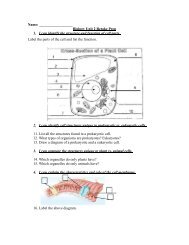Protist Observation Lab Background: ⢠Members of Kingdom Protista ...
Protist Observation Lab Background: ⢠Members of Kingdom Protista ...
Protist Observation Lab Background: ⢠Members of Kingdom Protista ...
Create successful ePaper yourself
Turn your PDF publications into a flip-book with our unique Google optimized e-Paper software.
<strong>Protist</strong> <strong>Observation</strong> <strong>Lab</strong><br />
<strong>Background</strong>:<br />
• <strong>Members</strong> <strong>of</strong> <strong>Kingdom</strong> <strong>Protist</strong>a are ______. (eukaryotic/prokaryotic)<br />
• <strong>Protist</strong>s are ______. (unicellular/multicellular/both)<br />
• Most protists live in ______ environments. (water/land)<br />
• Animal-like protists are ______. (heterotrophic/autotrophic)<br />
• The three ways animal-like protists move are _____, _____, and _____.<br />
• Plant-like protists are ______. (heterotrophic/autotrophic)<br />
• Fungus-like protists are ______. (heterotrophic/autotrophic)<br />
Purpose:<br />
The purpose <strong>of</strong> this lab is to observe the structure and movement <strong>of</strong> a variety <strong>of</strong> living protists.<br />
Hypothesis: None for this lab.<br />
Materials: “See lab handout”<br />
Microscope, slide, & coverslip<br />
<strong>Protist</strong> samples<br />
Colored pencils<br />
Biology textbook<br />
Procedure: “See lab handout”<br />
1. Prepare a wet-mount slide <strong>of</strong> each protist as demonstrated.<br />
2. Observe each protist under low, medium, and high power. Carefully draw each protist under high<br />
power and label the required internal structures.<br />
3. Observe and describe how each protist moves (not all <strong>of</strong> them do.)<br />
4. Rinse <strong>of</strong>f and return you slide and coverslip, return microscope.<br />
Data: You can observe/draw the protists in any order.<br />
AMOEBA<br />
1. Draw/color the amoeba, then use the internet to label the<br />
following parts:<br />
• Pseudopods, nucleus, cell membrane, cytoplasm, &<br />
food vacuoles<br />
2. Describe the amoeba’s movement.<br />
PARAMECIUM<br />
1. Draw/color the paramecium, use pg. 543 in your book to label the<br />
following parts:<br />
• Cilia, nucleus, cell membrane, cytoplasm, food vacuoles,<br />
contractile vacuole<br />
2. Describe how it moves.
EUGLENA<br />
1. Draw/ color the euglena, use page 546 to label the<br />
following parts:<br />
• Flagella, pellicle, nucleus, chloroplasts, eyespot<br />
2. Describe how it moves.<br />
STENTOR<br />
1. Draw/color the stentor.<br />
2. Describe how it moves.<br />
VOLVOX: do not use a coverslip!<br />
1. Draw/color the volvox.<br />
2. Describe how it moves.<br />
SPIROSTOMUM<br />
1. Draw/color the spirstomum.<br />
2. Describe how it moves.<br />
Contractile Vacuole<br />
Analysis:<br />
1. Compare and contrast the three basic means <strong>of</strong> movement used by animal-like protists.<br />
2. What is the function <strong>of</strong> chloroplasts in algae?<br />
3. Compare and contrast the way animal-like protists obtain energy with how plant-like protists obtain<br />
energy.<br />
4. What is purpose <strong>of</strong> the contractile vacuole in freshwater protozoans?<br />
5. What was your favorite protist to observe? Why?<br />
Conclusion: (Include three <strong>of</strong> the four parts since there is no hypothesis.)


